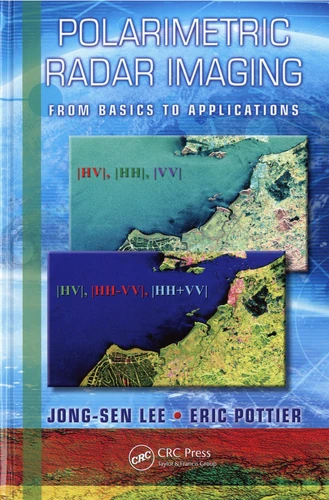Polarimetric Radar Imaging. From Basics to Applications
Par : ,Formats :
- Paiement en ligne :
- Livraison à domicile ou en point Mondial Relay indisponible
- Retrait Click and Collect en magasin gratuit
- Nombre de pages391
- PrésentationRelié
- FormatGrand Format
- Poids0.81 kg
- Dimensions16,0 cm × 24,1 cm × 3,0 cm
- ISBN978-1-4200-5497-2
- EAN9781420054972
- Date de parution01/02/2009
- ÉditeurCRC Press
Résumé
The recent launches of three synthetic aperture radar (SAR) satellites (ALOS-PALSAR, TerraSAR-X, and RADARSAT-2) with fully polarimetric SAR (PoISAR) mode have shown that polarimetric radar imaging can provide abundant data on the Earth's environment. Written by two of the most recognized leaders in this field, Polarimetric Radar Imaging : From Basics to Applications presents polarimetric radar imaging and processing techniques and shows how to develop remote sensing applications using polarimefric imaging radar.
The book introduces polarimetric scattering mechanisms, speckle statistics and speckle filtering, polarimetric information analysis and extraction techniques, and applications typical of radar polarimetric remote sensing. It explains the importance of wave polarization theory and the speckle phenomenon in the information retrieval problem of microwave imaging and inverse scattering. The authors demonstrate how to devise intelligent information extraction algorithms for remote sensing applications.
They also describe more advanced polarimetric analysis techniques for polarimetric target decompositions, polarization orientation effects, polarimetric scattering modeling, speckle filtering, terrain and forest classification, man-made target analysis, and PoISAR interferometry. With sample PoISAR data sets and software available for download, this self-contained, hands-on book encourages you to analyze space-borne and airborne PoISAR and polarimetric interferometric SAR (Pol-InSAR) data and then develop applications using this data.
The book introduces polarimetric scattering mechanisms, speckle statistics and speckle filtering, polarimetric information analysis and extraction techniques, and applications typical of radar polarimetric remote sensing. It explains the importance of wave polarization theory and the speckle phenomenon in the information retrieval problem of microwave imaging and inverse scattering. The authors demonstrate how to devise intelligent information extraction algorithms for remote sensing applications.
They also describe more advanced polarimetric analysis techniques for polarimetric target decompositions, polarization orientation effects, polarimetric scattering modeling, speckle filtering, terrain and forest classification, man-made target analysis, and PoISAR interferometry. With sample PoISAR data sets and software available for download, this self-contained, hands-on book encourages you to analyze space-borne and airborne PoISAR and polarimetric interferometric SAR (Pol-InSAR) data and then develop applications using this data.
The recent launches of three synthetic aperture radar (SAR) satellites (ALOS-PALSAR, TerraSAR-X, and RADARSAT-2) with fully polarimetric SAR (PoISAR) mode have shown that polarimetric radar imaging can provide abundant data on the Earth's environment. Written by two of the most recognized leaders in this field, Polarimetric Radar Imaging : From Basics to Applications presents polarimetric radar imaging and processing techniques and shows how to develop remote sensing applications using polarimefric imaging radar.
The book introduces polarimetric scattering mechanisms, speckle statistics and speckle filtering, polarimetric information analysis and extraction techniques, and applications typical of radar polarimetric remote sensing. It explains the importance of wave polarization theory and the speckle phenomenon in the information retrieval problem of microwave imaging and inverse scattering. The authors demonstrate how to devise intelligent information extraction algorithms for remote sensing applications.
They also describe more advanced polarimetric analysis techniques for polarimetric target decompositions, polarization orientation effects, polarimetric scattering modeling, speckle filtering, terrain and forest classification, man-made target analysis, and PoISAR interferometry. With sample PoISAR data sets and software available for download, this self-contained, hands-on book encourages you to analyze space-borne and airborne PoISAR and polarimetric interferometric SAR (Pol-InSAR) data and then develop applications using this data.
The book introduces polarimetric scattering mechanisms, speckle statistics and speckle filtering, polarimetric information analysis and extraction techniques, and applications typical of radar polarimetric remote sensing. It explains the importance of wave polarization theory and the speckle phenomenon in the information retrieval problem of microwave imaging and inverse scattering. The authors demonstrate how to devise intelligent information extraction algorithms for remote sensing applications.
They also describe more advanced polarimetric analysis techniques for polarimetric target decompositions, polarization orientation effects, polarimetric scattering modeling, speckle filtering, terrain and forest classification, man-made target analysis, and PoISAR interferometry. With sample PoISAR data sets and software available for download, this self-contained, hands-on book encourages you to analyze space-borne and airborne PoISAR and polarimetric interferometric SAR (Pol-InSAR) data and then develop applications using this data.


